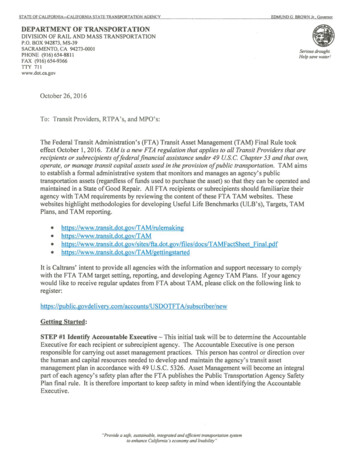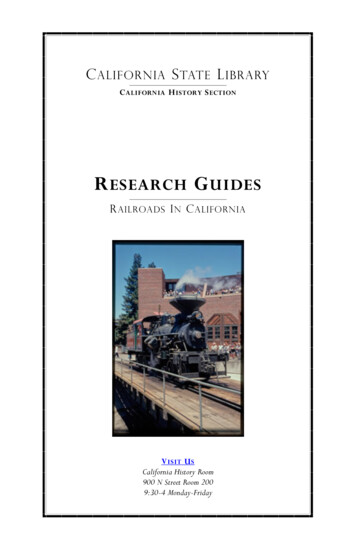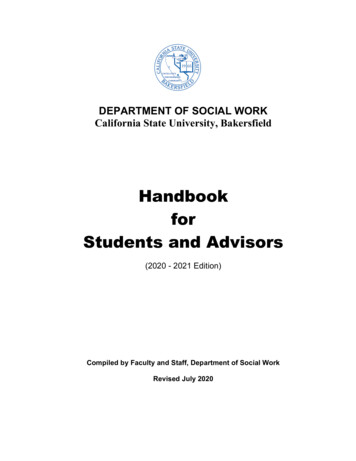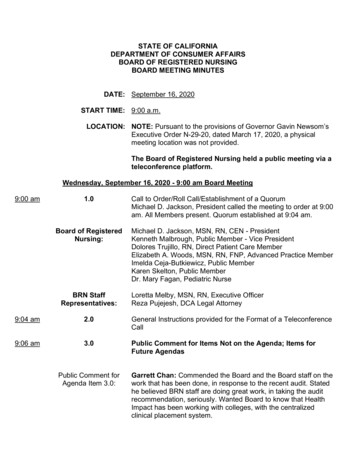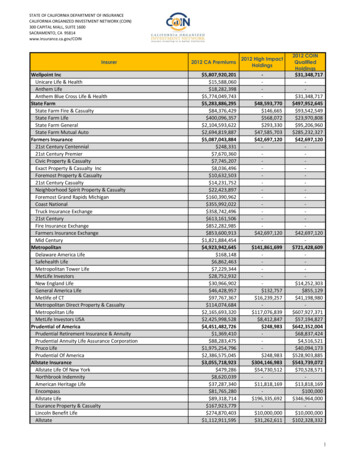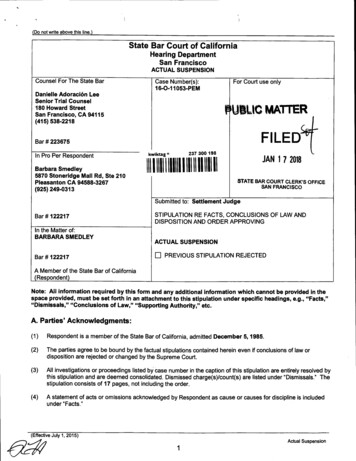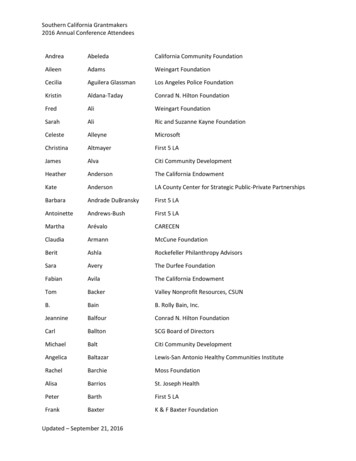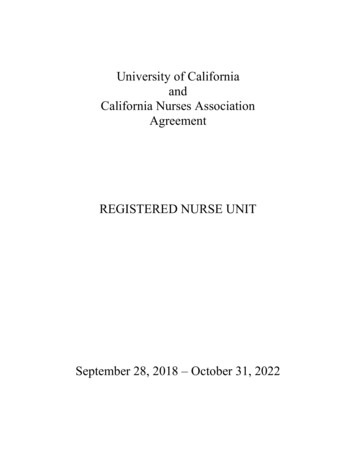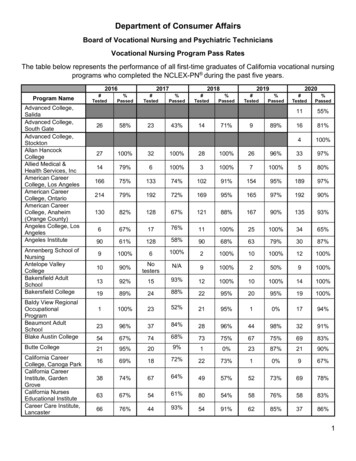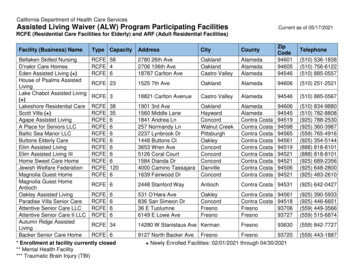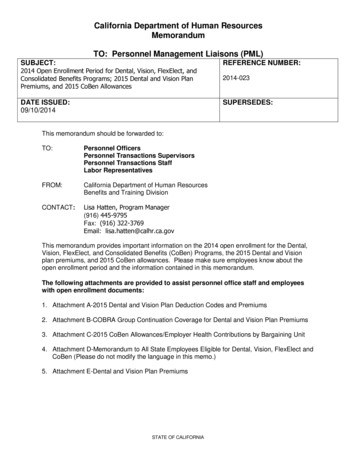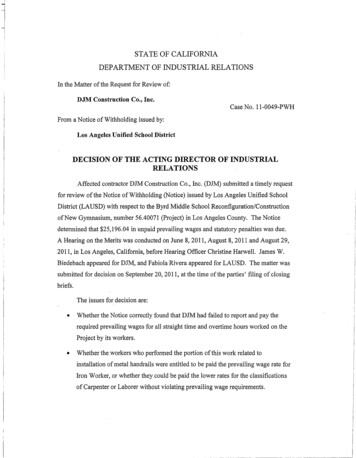
Transcription
STATE OF CALIFORNIADEPARTMENT OF INDUSTRIAL RELATIONSIn the Matter of the Request for Review of:DJM Construction Co., Inc.Case No. 11-0049-PWHFrom a Notice of Withholding issued by:Los Angeles Unified School DistrictDECISION OF THE ACTING DIRECTOR OF INDUSTRIALRELATIONSAffected contractor DJM Construction Co., Inc. (DJM) submitted a timely requestfor review ofthe Notice of Withholding (Notice) issued by Los Angeles Unified SchoolDistrict (LAUSD) with respect to the Byrd Middle School Reconfiguration/Constructionof New Gymnasium, number 56.40071 (Project) in Los Angeles County. The Noticedetermined that 25,196.04 in unpaid prevailing wages and statutory penalties was due.A Hearing on the Merits was conducted on June 8, 2011, August 8, 2011 and August 29,2011, in Los Angeles, California, before Hearing Officer Christine Harwell. James W.Biedebach appeared for DJM, and Fabiola Rivera appeared for LAUSD. The matter wassubmitted for decision on September 20,2011, at the time of the parties' filing of closingbriefs.The issues for decision are: Whether the Notice correctly found that DJM had failed to report and pay therequired prevailing wages for all straight time and overtime hours worked on theProject by its workers. Whether the. workers who performed the portion of this work related toinstallation of metal handrails were entitled to be paid the prevailing wage rate forIron Worker, or whether they could be paid the lower rates for the classificationsof Carpenter or Laborer without violating prevailing wage requirements.
Whether one worker, Jesus Reyes, who was required to use ajackhammer on oneor more days, was entitled to be paid the prevailing wage rate for Laborer Group 3when that work was performed, or whether he could be paid the lower rates forthe classification of Laborer Group 1 for that work. Whether training fund contributions on the assessed unpaid wages in the Noticewere required. Whether Los Angeles Unified School District (LAUSD) abused its discretion inassessing penalties under Labor Code section 1775 1 at the maximum rate of 50.00 per violation. Whether DJM failed to pay the required prevailing wage rates for overtime workand is therefore liable for penalties under section 1813. Whether DJM has demonstrated substantial grounds for appealing the Notice,entitling it to a waiver of liquidated damages.The Acting Director finds that DJM has failed to carry its burden of proving that thebasis of the Notice was incorrect. Carpenter prevailing wages are not appropriate formetalhandr ilinstallation, which should have been paid at the Iron Worker prevailingwage rate, and Jesus Reyes should have been paid as a Laborer, Group 3 for the days heworked utilizing ajack hammer. However, some ofthe days LAUSD assessed were notsubstantiated and DJM has carried its burden of disproving the basis of the Notice as tothe unpaid wages and associated penalties assessed for those days; the Notice is modifiedaccordingly. Penalties under section 1775 are affirmed, as modified, and DJM has failedto prove grounds for waiving liquidated damages. Therefore, the Acting Director ofIndustrial Relations modifies and affirms the Notice.The Los Angeles Unified School District (LAUSD) advertised the Project for bidon February 4, and February 11, 2008; it awarded the contract to DJM on April 11, 2008.DJM performed services reconfiguring and constructing a gymnasium for Byrd Middle1All further statutory references are to the California Labor Code, unless otherwise indicated.Decision of the Acting Director ofIndustrial Relations-2-11-0049-PWH
School over the period May 18, 2008, through September 6, 2009, utilizing 15 workers.As part ofthe Project, DJM upgraded cement walkways, refinished floors, reconfiguredthe bathrooms, installed lighting and installed new handrails in walkway areas. DJMpaid its workers based on the prevailing wage rates for Laborers, Groups 1 and 3, and forCarpenters. DJM paid the training funds respectively to the Construction Laborers TrustFund and Carpenters Trust Fund. In July, 2009, the Sheet Metal Workers InternationalAssociation, Local Union 105, filed a complaint with LAUSD advising that DJM failedto pay fringe benefits to Local 105 and improperly used carpenters to install metalhandrails; work that should have been performed by Iron Workers. An audit wasconducted that assessed DJM for violations for misclassification ofthe workers, some asIron Workers, others as Cement Masons, and Jesus Reyes at a higher Laborer, Group 3classification on the few days Reyes was required to use ajackhammer. Additionally, theNotice found that DJM failed to report and underpaid some of the workers based onreview ofDJM's Certified Payroll Records (CPRs) and workers' weekly payrollstatements (Weekly Statements) when compared to the sheets on which the workerssigned in and out of the jobsite each day (Daily Sign-In).Applicable Prevailing Wage Determinations (PWDs): The following applicablePWDs and scopes of work were in effect on the bid advertisement date:Laborer, for Southern California (SC23-1-102-2-2007-l), Group 1: This ratespecifically applies to 25 listed categories of Laborer Group 1 work with such items aspanel forms, concrete, demolition, clean-up; and as described by the August 22,2007,Notice regarding advisory scope of work for the Southern California Laborers' GeneralPrevailing Wage Determination, which includes:Certified Confined Space Laborer; Concrete Curb and Gutter Laborer;Environmental, Remediation, Monitoring Well, Toxic Waste,Geotechnical Drill Helper; Expansion Joint Caulking by any method(including preparation and clean-up); Laborer, Concrete; Laborer,Asphalt-Rubber Material Loader, and, Traffic Control Pilot Truck,Vehicle Operator in connection with all Laborer's work.Laborer, for Southern California (SC23-102-2-2007-1), Group 3: This ratespecifically applies to 20 listed categories of Laborer Group 3 work with such items asDecision of the Acting Director ofIndustrial Relations-3-11-0049-PWH
II Buggymobile man; Compactor; Concrete Cutting Torch; Concrete, Pile Cutter; Driller,Jackhammer, and other listed tasks; and as described by the August 22,2007, Noticeregarding advisory scope of work for the Southern California Laborers' GeneralPrevailing Wage Determination, which includes: "Asphalt Installation of all fabrics,Bushing Hammer, Guardrail Erection/Guardrail builders; Shot Blast Equipmentoperators; and Small Skid Steer Loader."Carpenter, for Los Angeles County CSC-23-31-2-2007-2): This is the rate used byDJM for concrete form work, as described by the advisory Scope of Work Provisionsdated February 22,2007, that apply section 102.5.7 ofthe July 1998 Carpenters MasterLabor Agreemene: .All concrete form work, including, but not limited to the fabrication,construction, placing, erection, rigging and hoisting, stripping andremoving of all forms and operation of the fork lift, leod, pettibone ormobile equipment in reference all ofthe above work.Iron Worker for Southern California CC-20-X-I-2007-l): This is the rate used inthe Notice for "work involving field fabrication and/or erection of structural, ornamentaland reinforced steel .," as described in the applicable scope of work for Iron Worker.Use of Carpenters and Laborers to Install Metal Handrails: The Noticedetermined that DJM paid Rob Frazer at the Carpenter's rate, Reyes at the Laborer'sGroup 3 rate, and Lino Herrera at the Laborer's 1 rate during the period from April 2through April 4, 2009. The Notice determined that these workers should have been paidusing the Iron Workers pay rate during that period.Frazer, Reyes, and Herrera installed prefabricated heavy metal rails into predrilledholes in concrete walls, leveled them and applied grout cement to set and affix them inthe holes. Nancy Morada, LAUSD'S Labor Compliance Officer, testified that the solebasis for reclassifying the three workers to Iron Workers was because they were installingheavy metal, as reported to her by the Inspector.That agreement, adopted by Prevailing Wage Determination SC-23-31-2-2007-2. is between AssociatedGeneral Contractors of California, Inc., Building Industry Association of Southern California, Inc.,Southern California Contractors Association, Inc., Millwright Employers Association, Inc. and SouthernCalifornia Conference of Carpenters on behalf of the District Councils and Local Unions in the Eleven (II)Southern California Counties Affiliated with United Brotherhood of Carpenters and Joiners of America.2Decision ofthe Acting Director ofIndustrial Relations-4-11-0049-PWH
After receiving the Notice and attending a July 7, 2010, meeting with LAUSD,DJM's project manager, Jason Murray countered LAUSD's Iron Worker reclassificationby writing July 9, 2010:The handrails for this project were prepared in full offsite and galvanizedoffsite by our miscellaneous metal suppliers. They were deliveredcomplete FOB to the job site. My carpenters took the handrails andinstalled them in predrilled holes in the concrete stairs/ramps. Thehandrails were shored up in place with wood framing materials at theproper elevations and then non-shrink grout was used to secure them inplace. When cured, the shoring was removed by my carpenters. We feelthis handrail installation is covered under the Carpenters' acceptable scopeof work provisions.At hearing Murray said essentially the same, and explained that the workers hadpredrilled holes where the handrail was supposed to go on the ramp and sidewalk. Theworkers would then take the handrails, support them with their formwork at the properelevation, set them in the holes and install them with grout. It took no assembly of themetal rails; the forms used by the workers were wooden and the workers did the groutwork. Murray relied on section 102.5.7 of the Carpenters scope of work quoted above.Murray had not been present when the handrails were installed, so there was no evidenceto confirm the process as described by Murray. Murray, who started working on theProject after it began, did not know ifDJM asked the Division of Labor Statistics andResearch if the advisory scope of work for carpenters could be used for the installation ofthe metal rails.Herrera was the only one of the three workers who installed the handrails whotestified at trial, but neither DJM nor LAUSD asked him about the handrail installationprocess.Misclassification of Reyes as Laborer, Group 1: The Notice also reclassifiedReyes, who was paid as Laborer, Group 1, for work on August 24,2008, AprilS, 2009,and May 3, 10, and 17,2009, when Reyes performed jack hammering of concrete. Reyesdid not testify. At hearing Murray stated that LAUSD considered that some demolitionwork around some concrete slabs in one of the classrooms was necessary so that DJM'selectricians could fix the conduit that was broken underneath the concrete. The work didDecision of the Acting Director ofIndustrial Relations-5-11-0049-PWH
require use of a jack hammer for chipping and grinding. Murray believed that work fellunder the scopes of work for Laborer Groups 1,3 or 4. DJM paid Reyes at the LaborerGroup 1 rate for that work because that subclassification includes concrete work.Failure to Report and Pay Days of Work: LAUSD determined that DJM hadunder reported the hours its workers worked on the Project. Morada stated that wheninvestigating the installation of handrails, DJM's payroll records came under scrutiny.DJM required the workers to sign in and out each day on the Daily Sign-Ins, whichMorada considered to be the best source of information ofthe actual days and hoursworked. She interviewed workers, some ofwhom testified at hearing, who agreed theDaily Sign-Ins were true statements of their hours.DJM maintained the Daily Sign-Ins as well as Weekly Statements for eachworker, which it required the workers to sign before being paid. DJM did not allowworkers to compare whether the Weekly Statements coincided with the hours on theDaily Sign Ins. Morada concluded the discrepancies between the Daily Sign-Ins and theWeekly Statements showed that DJM had underreported hours.DJM contends that the Daily Sign-Ins were not intended to be records of hoursworked by the workers. Instead, the Weekly Statements were DJM's primary source, andthe workers were expected and required to sign-off as to the accuracy of the hours theWeekly Statements contained. Yvonne Dominguez, DJM's Payroll Administrator,testified that the Weekly Statements were prepared by someone "in the field," and thesource of the information was not known to Dominguez. Dominguez never saw theDaily Sign Ins until LAUSD demanded production of all of its documents. DJMproduced several workers who stated that they did not consider that the Daily Sign-Inswere time-keeping documents. Each stated they believed they were paid correctly byDJM for their time. The workers posited that even though the workers may have signedin at one time, they often began work later after gathering their tools and heading to theirparticular work site. George Banzon, a Carpenter, testified that he was required to sign the WeeklyStatement and he would check to see if it was correct. Ifhe was unable to signDecision ofthe Acting Director ofIndustrial Relations-6-II-0049-PWH
the Daily Sign-In, DJM would pay him for his hours anyway. He signed theDaily Sign-Ins when he arrived and when he left; each time he would writedown the time he arrived and that time he left. He did not consider the DailySign-In accurate. He sometimes would sign in and spend up to15 minutes toprepare his tools and other implements. Herrera, a Laborer, Group 3, testified that he signed the Daily Sign-Ins andstarted working as soon as he signed and stopped working at the time he signedout. All the workers would sign in at the time they started to work, at least by6:30 AM. Herrera would keep his time on a personal memo, but, after signingoff on the Weekly Statement, he would throwaway his personal memo of hoursthat he had worked. Eduardo Martinez, a Carpenter, did not agree that all who signed in beganworking right away. His hours were from 6:00 AM to 2:30 PM, but becausethey were working in a residential area, work that created noise could not beginuntil later. According to Martinez, the purpose of signing in was to allow DJMto know who was present. After Martinez signed in, he would begin bringingout his cables and tools for the construction. When he signed out, he had alreadypicked up his materials. Gerardo Zamora, a Carpenter, testified that the Daily Sign-Ins reflected theactual hours he worked each day. When asked what he did when he signed in,Zamora said it would depend: if they started at 6:30 it meant he would sign inand go to his place and start working. He explained that he did not have togather his tools because there were laborers who would bring materials to him towork with so he would go straight to work. When he signed out, he might havestill picked up his tools. Before he went home he would always sign out, whichwas required. David Lopez, a Carpenter, testified that he signed in and out on the Daily Sign In, with the time noted when he arrived and when he left, and that the DailySign-Ins were an accurate representation of the time he spent working on theDecision ofthe Acting Director ofIndustrial Relations-7-11-0049-PWH
Project. One day was missing an entry for Lopez, but he was paid anyway;Lopez could not explain why that occurred. Lopez was also required to sign theWeekly Statements, which he did not compare to the Daily Sign-Ins.The testimony about the Daily Sign-In rosters versus the Weekly Statements andthe Inspector of Record's (lOR) reports was extensive. The variances in time weremostly small incidences of overtime for about 1'2 hour past an 8 hour day; however therewere several entire work-days, mostly on weekends, that DJM had reported no workers.Morada said that she compared the Daily Sign-ins to the ePRs and found somedays entirely unreported. However, DJM showed that the lOR daily diary of who waspresent confirmed there was no work at all on many weekend days for which LAUSDsaid workers were not paid or listed on the ePRs but for which Morada considered thereto be Sign-In rosters. DJM contended that the Sign-In rosters themselves had obviouserrors that provided evidence that none of the Sign-Ins were accurate. Many werecontradicted by the IORs. At hearing the District stipulated to the withdrawal of theassessment for eight workers on June 14,2009, because, even though there appeared tobe a Daily Sign-In roster signed on that day, the lOR reports and the ePRs had no workfor that day.3 DJM identified two other days, May 9, and May 16, 2009, for which therewere Daily Sign-Ins but no IORs or ePRs that reported work. Nevertheless, the Noticeclaims eight hours unpaid for Banzon on May 9,2009, and eight hours each forDeGeneffe, Toscano, Navarro, Banzon and Frazer on May 16,2009.There was further testimony about December 13,2008, for which the Daily Sign In showed workers signing in but not out. Morada realized while testifying that thisdocument was aduplicate of the December 12,2008 Sign-In roster which had beenmisidentified for December 13,2008. 4 Even after determining at hearing that there hadNevertheless, despite that stipulation, LAUSD submitted a chart with its post hearing brief that stillassessed 8 unreported hours for Sunday, June 14,2009 for workers: George Banzon, Christian DeGeneffe;Daniel Toscano; David Navarro; Reyes; Herrera and Frazer.3Morada claimed she had never received the right December 13 Sign-In roster from DJM, but DJMestablished that she had been provided with it prior to the hearing.4Decision of the Acting Director ofIndustrial Relations-8-11-0049-PWH
1,been an error for December 13,2008, LAUSD continued its assessment for two workersfor December 13, 2008.Dominguez explained that the Notice incorrectly assessed wages on April.!7,2009, for Banzon who actually had worked on April 18, 2009; a Saturday. Banzonworked in the office on that date for five hours and was paid separately. It was DJM'sinput processer, Carla, who erred in attributing Banzon's non-prevailing wage officework as prevailing wage work on the CPR for the prior day, Friday, April 17.Joe Fuchs, DJM's supervisor who would have been the best source to explain whythe Daily Sign-Ins were not a time-keeping document, or how he determined the workhours for the workers' payments, did not testify. No LAUSD inspector testified.Based on the variances between Daily Sign-Ins and Weekly Statements, LAUSDasserts that workers were not paid overtime or weekend wages they were entitled toreceive. Nearly every increased assessment included an overtime assessment, resulting inadditional straight time wages due for 59 days, and adding 164.75 hours of unpaidovertime (including 5 hours of double-time) and penalties under section 1813 for eachday in excess of 8 hours, or for weekend work.Underpaid Fringe Benefit Payments Based on Misclassification or UnderreportedHoursBased on the underreported hours and failure to pay appropriate Iron Worker orLaborer 3 classification, LAUSD assessed DJM with failure to pay appropriate fringebenefits and training funds.The Notice: The Notice found that DJM failed to pay the required prevailingwages, including failure to pay the required prevailing wage rate for overtime,misclassified employees and failed to make the required training fund contributions forany of the affected workers. The Notice found a total of 17,421.86 in unpaid prevailingwages, including 149.78 in unpaid training fund contributions. Penalties were assessedunder section 1775 in the amount of 50.00 per violation for 113 violations, totaling 5,650.00. LAUSD determined that the maximum penalty was warranted by its findingsthat workers systematically were misclassified and were not paid for all their hours, thatDecision of the Acting Director ofIndustrial Relations-9-11-0049-PWH
DJM had prior incident
Whether Los Angeles Unified School District (LAUSD) abused its discretion in assessing penalties under Labor Code section 1775 1 at the maximum rate of 50.00 per violation. Whether DJM failed to pay t
